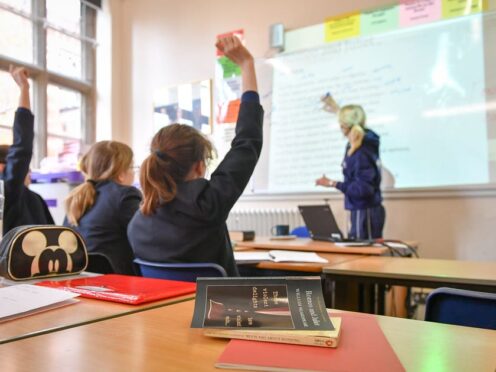
Pupils who have been suspended from secondary school are, on average, around a year behind their peers who have never been suspended, a report has suggested.
Suspended pupils tended to have lower GCSE grades even after accounting for other factors – such as demographics, socio-economic disadvantage, prior attainment and school characteristics, according to think tank Education Policy Institute (EPI).
The paper, commissioned by charity Impetus, found that pupils with even just one suspension are, on average, not achieving a “standard pass” (a grade 4) in GCSE English and maths.
It comes after recent Government figures showed that school suspensions have been rising.
Suspensions, previously known as fixed period exclusions, refer to when a pupil is excluded from a school for a set period of time.
The EPI research studied a cohort of 585,827 state school pupils in England who started Year 7 in 2014 and it followed their progress throughout school until they sat their GCSEs in 2019.
It concluded that “suspended pupils were, on average, approximately 12 months behind their not-suspended peers”.
The report added: “It is important to remember that we cannot claim that suspensions cause lower attainment.
“Several factors can influence the risk of being suspended as well as the risk of low attainment (e.g. socioeconomic disadvantage).
“Therefore, it can be challenging to disentangle the effects of a suspension from those associated with other vulnerabilities in a pupil’s life.”
Pupils with social, emotional or mental health needs were more likely to be suspended, the report found.
Pupils suspended 10 times were almost three times as likely to be identified with special education needs or disabilities (Send) as pupils who were suspended once, it added.
The report has called on schools and colleges to be equipped with the resources and skills to recognise pupils with mental health and other needs to ensure they receive effective support.
Schools should proactively identify those at risk of suspension and plan early intervention to reduce the need for suspension, it added.
The research found pupils with multiple suspensions are less likely to be in a mainstream school and more likely to be in alternative provision (AP) by the time they sit their GCSEs.
The think tank has called on the Government to work with Ofsted to ensure that pupils who are suspended have access to high quality education.
Department for Education (DfE) figures published in November showed there were 247,366 suspensions in schools in England in the autumn term of 2022.
This was higher than in the autumn term of 2021 when there were 183,800 suspensions, and higher than the autumn term before the Covid-19 pandemic (178,400 suspensions).
The report suggested that more research was needed to understand the drivers behind the rise in suspensions to inform more effective interventions.
Whitney Crenna-Jennings, associate director for mental health and wellbeing at the EPI, said: “Given the strong link between the number of suspensions from secondary school and poorer education outcomes, it is vital that schools work proactively to reduce the number of suspensions and are given the resources that they need to identify pupils with mental health and additional needs, to make early intervention possible.
“Recognising that some pupils will require alternative provision (AP), the Department for Education should work with Ofsted to ensure that those who are suspended have access to a high-quality education.”
Ben Gadsby, head of policy and research at private equity foundation Impetus, said the research puts a number on the “suspension grades gap” for the “first time”.
He said: “With only half the reason for these different outcomes being explained by measurable differences between pupils and schools, this is an important finding about the need to focus on the underlying issues that reduce pupil’s chances of succeeding in school.
“While suspensions are sometimes necessary, supporting pupils who are struggling to engage in mainstream education must continue to be a priority for whoever is in government.”
Geoff Barton, general secretary of the Association of School and College Leaders (ASCL), said early intervention and sufficient resources and training are key to “reducing the rate of suspensions” in schools.
He added: “However, the special educational needs system is in a state of crisis, with delays in assessments, lack of resources, disputes between parents and local authorities, and massive deficits in local authority high-needs budgets.
“The Government’s plans to improve the system are years away from being delivered and lack the essential component of sufficient funding. It is a lamentable situation – children and young people need this support right now.”
A DfE spokesperson said: “The Government is very clear it backs head teachers to use suspensions and permanent exclusions where required, so they can provide calm, safe, and supportive environments for children to learn in.
“Our reforms set out a new model for alternative provision schools to work with mainstream settings to provide targeted support to children with additional needs early on, which will increase attendance and allow schools to support pupils who are at risk of exclusion.”

Enjoy the convenience of having The Sunday Post delivered as a digital ePaper straight to your smartphone, tablet or computer.
Subscribe for only £5.49 a month and enjoy all the benefits of the printed paper as a digital replica.
Subscribe